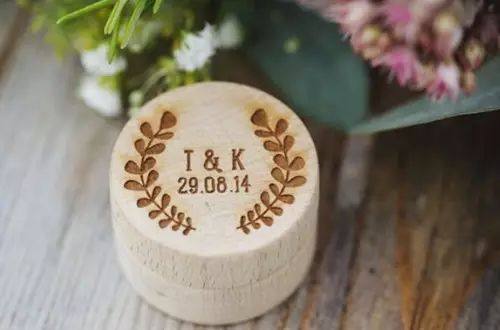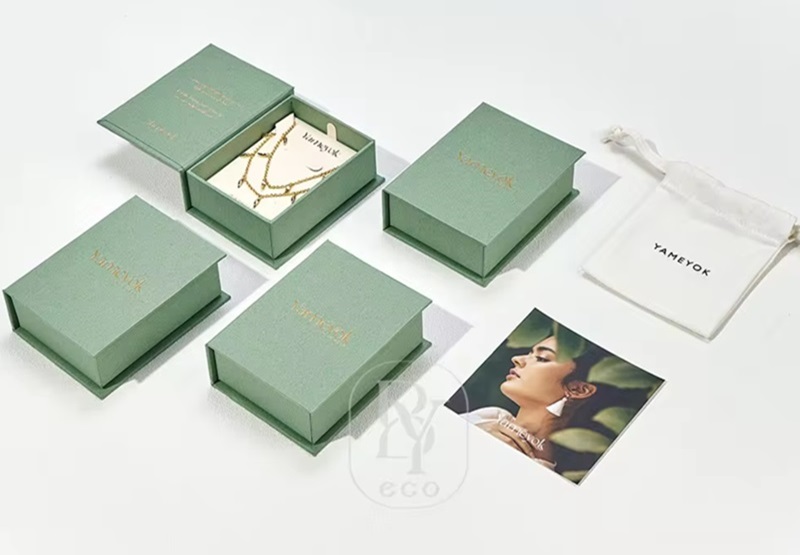You can share
- Share to Facebook
- Share to Google+
- Subscribe to our
- Share to Linkedin
- Share to Twitter

In the world of jewelry, custom jewelry boxes are like a dazzling art palace, carrying the endless beauty of craftsmanship. Every custom jewelry box is the crystallization of the craftsmen's efforts and wisdom, and they show amazing charm with unique craftsmanship.
The beauty of the craftsmanship of custom jewelry boxes is first reflected in the exquisite selection of materials. High-quality cardboard, or wood, such as precious red sandalwood, huanghuali, or delicate beech, are carefully selected as raw materials for making jewelry boxes. These woods are solid and beautiful in texture and give the jewelry boxes a noble and elegant temperament. In addition, gorgeous leather, exquisite silk, and other materials are often used, adding rich texture and touch to the jewelry boxes.

And the exquisite carving craftsmanship is a highlight of custom jewelry boxes. With their skilled skills, craftsmen carve various exquisite patterns and decorations on the surface of jewelry boxes.
From ancient times to the present, the development history of jewelry boxes has been long rich, and diverse. Jewelry boxes were widely used in ancient Egypt as early as 5000 BC. At that time, most Egyptians, regardless of gender or age, would wear jewelry. They especially loved gold, which was usually paired with a variety of precious gems, so they needed larger packaging boxes that could protect the jewelry safely.
In Rome, jewelry was a symbol of status, and only those who reached certain levels were allowed to wear jewelry such as rings and brooches.
Before the Victorian era, jewelry was a rare luxury. Only a few royal families and members of the upper class had enough jewelry to store, so jewelry boxes were only their privilege.
After the Industrial Revolution, high-end jewelry became more and more popular. As stone, metal, etc. can be cut mechanically, the cost is reduced, and jewelry is owned by more and more people, and people's demand for jewelry boxes is also stronger. At this time, small ornaments became popular, and jewelry boxes were much smaller than traditional ones.
In modern times, generally valuable jewelry is stored in safes or special rooms, so modern jewelry boxes rarely have insurance facilities. Their main function is to prevent jewelry from being scratched and oxidized during transportation or storage. Although many gemstones are hard and do not oxidize, jewelry such as amethyst and jade can easily depreciate if exposed to direct sunlight or high temperatures for a long time, which makes jewelry boxes more necessary for protection.
Since the early 20th century, jewelry box design styles have become more diverse. Art Nouveau style advocates natural materials and elements and conveys a sense of organic luxury with rich wood tones, relief glass, and mosaic patterns.

Tiffany's studio in the early 20th century has been making jewelry boxes since the late 19th century, and by 1910 it had significantly expanded its jewelry box design range and introduced a wider range of styles. At the same time, Art Deco made its debut, in stark contrast to the elegant luxury of Art Nouveau. Art Deco style celebrates the striking nature of geometric shapes from inlaid or carved wood to highly polished metal. The meticulously crafted streamlined jewelry boxes are both eye-catching and sculptural, making them useful as jewelry boxes or as independent display works of art.
In the 1930s, World War I limited access to basic goods, and the Great Depression in the United States also silenced the economy, leading to a decline in the extravagance of 1910-1920. Despite this, jewelry remained popular, as did jewelry boxes, but there was a greater focus on economical design and cost-effective materials, one of which was Bakelite.
In the 1950s, the modern design style completely replaced the streamlined style of Bakelite. This style was encompassed in the work designed by international teams such as American designers Herman Miller and Paul McCobb and A. Bender Madsen and Ejner Larsen of Denmark. Following the old adage "form follows function", these designers sought a simple and stylish approach, abandoning the ornate or classic themes of previous eras and embracing simple geometric shapes and bold colors. During this period, jewelry boxes and dressing tables were often integrated directly into larger furniture, making the furniture more diverse.
By the end of the 20th century, the key themes of early jewelry box design paved the way for a diverse range of styles. Classic silver carved jewelry boxes, similar to those popular in the early 20th century, combined with modernist techniques and materials popular in the 1960s and 1970s, formed a variety of styles and decorative patterns.
From ancient times to the present, people's demand for jewelry boxes has never diminished. As can be seen from the development history of jewelry boxes, they are works of art just like earrings, rings, bracelets, and necklaces. Whether you are an avid jewelry lover or just looking for an eye-catching container, custom jewelry boxes are sure to meet all your needs.